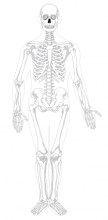- Home
- About
- Partners
- Newcastle University
- University of L'Aquila
- University of Manchester
- Alacris Teranostics GmbH
- University of Pavia
- Polygene
- Consiglio Nazionale delle Ricerche
- INSERM
- Certus Technology
- Charité Universitaet Medizin
- GATC Biotech
- University Medical Center Hamburg Eppendorf
- Evercyte GmbH
- University Hospital of Cologne
- PRIMM Srl
- University of Freiburg
- University of Antwerp
- Finovatis
- Research
- SYBIL at a glance
- Bone
- Growth plate
- Desbuquois dysplasia
- Diastrophic dysplasia
- MCDS
- Osteopetrosis
- Osteoporosis
- Osteogenesis imperfecta
- Prolidase deficiency
- PSACH and MED
- Systems biology
- SOPs
- Alcian Blue staining
- Bone measurements
- BrdU labelling
- Cell counting using ImageJ
- Chondrocyte extraction
- Cre genotyping protocol
- DMMB assay for sulphated proteoglycans
- Densitometry using ImageJ
- Double immunofluorescence
- Electron microscopy of cartilage - sample prep
- Extracting DNA for genotyping
- Grip strength measurement
- Histomorphometry on unon-decalcified bone samples
- Immunocytochemistry
- Immunofluorescence
- Immunohistochemistry
- Quantitative X-ray imaging on bones using Faxitron and ImageJ
- Skeletal preps
- TUNEL assay (Dead End Fluorimetric Kit, Promega)
- Toluidine Blue staining
- Toluidine Blue staining
- Von Kossa Gieson staining
- Wax embedding of cartilage tissue
- Contact Us
- News & Events
- Links
- Portal
Our research
What is SYBIL?
 The European Commission has awarded over £10,000,000 (€12m) to SYBIL, a five year project involving 18 partners across Europe, which hopes to make breakthroughs in the treatment of the rare and common skeletal diseases, which affect tens of thousands of people in the UK and across Europe. Using mouse models of 60 distinct genetic variants as well as pluripotent stem cells, zebrafish and conventional cell culture systems, the project aims to find the genetic causes of both common and rare skeletal diseases, to understand disease processes and age-related changes and to deliver new disease biomarkers and identify targets for treatments. In order to achieve this, SYBIL will employ many cutting edge laboratory techniques, including generation of genetically modified animal models of disease, production of induced pluripotent cells (iPS) from patient biopsies, next generation sequencing and systems biology approaches, in order to gain understanding of the complex biology of cartilage and bone tissue in health and disease.
The European Commission has awarded over £10,000,000 (€12m) to SYBIL, a five year project involving 18 partners across Europe, which hopes to make breakthroughs in the treatment of the rare and common skeletal diseases, which affect tens of thousands of people in the UK and across Europe. Using mouse models of 60 distinct genetic variants as well as pluripotent stem cells, zebrafish and conventional cell culture systems, the project aims to find the genetic causes of both common and rare skeletal diseases, to understand disease processes and age-related changes and to deliver new disease biomarkers and identify targets for treatments. In order to achieve this, SYBIL will employ many cutting edge laboratory techniques, including generation of genetically modified animal models of disease, production of induced pluripotent cells (iPS) from patient biopsies, next generation sequencing and systems biology approaches, in order to gain understanding of the complex biology of cartilage and bone tissue in health and disease.
SYBIL project studies diseases which primarily affect the formation and homeostasis of:
- bone
- articular cartilage
- growth plate cartilage
For a comprehensive overview of the SYBIL project, please have a look at the video below:
Rare Skeletal Diseases (RSDs)
RSDs comprise an extremely diverse and complex group of diseases that primarily affect the developing skeleton. There are more than 450 unique and well-characterised conditions that range in severity from relatively mild to severe and lethal forms. Although individually rare, as a group of related orphan diseases, RSDs have an overall prevalence of at least 1 per 4,000 children, which extrapolates to a minimum of 225,000 people in the 27 member states and candidate countries of the EU.
Please click on the links below to find out more about the rare skeletal diseases studied under the SYBIL project:
- diastrophic dysplasia
- Desbuquois dysplasia
- osteogenesis imperfecta
- osteopetrosis
- prolidase deficiency
- pseudoachondroplasia and multiple epiphyseal dysplasia
- spondylometaphyseal dysplasia type Schmidt
- osteomalacia
Common Skeletal Diseases (CSDs)
Among the CSDs that will be investigated are osteoarthritis (OA) and osteoporosis (OP). Osteoarthritis (OA) is the most common form of arthritis. The World Health Organisation estimates that 25% of adults aged over 65 years suffer from pain and/or disability from OA and it is ranked 12th for disease burden in the EU25 as 35-40 million people suffer from OA in Europe. OA is estimated to be 30-70% genetic with strong environmental risk factors of ageing, obesity and joint trauma. Osteoporosis (OP) is also a polygenic disease in which the quality and density of bones is reduced leading to weakness and increased risk of fractures. OP and its associated fractures are a major cause of morbidity and mortality since the lifetime risk for osteoporotic fractures in women is 30-50% and in men is 15-30%. Both osteoarthritis and have a rising prevalence with age and result in a loss of independence with a greatly reduced quality of life and represent a major healthcare burden of increasing scale in Europe with the projected expansion of the elderly population.
Click below to read more about:
- osteoarthritis
- osteoporosis
“SYBIL brings together a group of world-class scientists, systems biologists, disease modellers, information technologists and industrialists that will achieve critical mass to deliver the ambitious objectives of this programme of research. This project has great potential to improve the lives of hundreds of thousands of people. If we can identify the genes and the biomarkers that cause these dieses then we can think about developing treatments which could really help people.” Michael Briggs, Professor of Skeletal Genetics at Newcastle University, SYBIL project coordinator.


